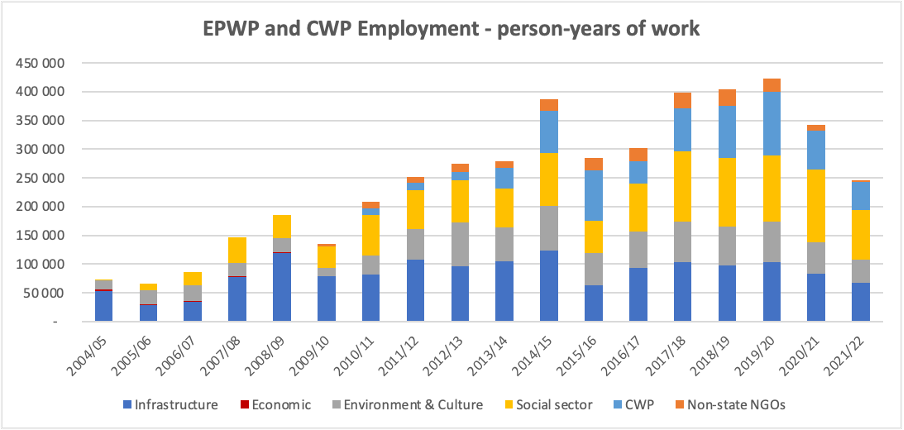Public employment programmes: what they contribute to jobs and earnings
The rise and decline of EPWP and CWP employment
The 2012 National Development Plan (the NDP) – Our future: make it work – put employment at the centre of South Africa’s economic reconstruction challenge. Three key priorities were highlighted:
- Raising employment though faster economic growth
- Improving the quality of education, skills development, and innovation
- Building the capability of the state to play a developmental, transformative role.
But the NDP recognised that employment creation through growth would not be enough. Amongst the measures proposed to attack poverty directly was the expansion of public employment programmes – to one million participants by 2015 and two million by 2020.
The official “Monitoring and Evaluation” (M & E) reports of the Expanded Public Works Programme (EPWP) published on the Department of Public Works and Infrastructure (DPWI) website provide a measure of progress against these targets.[1] The reports indicate that the 2015 goal was met in 2014/15, following a decade of broadly steady growth in the EPWP and the rapid growth of the Community Work Programme (CWP), first piloted in 2007 and introduced into these reports in 2010/11.
However, in 2015/16 both work opportunities and full-time equivalent person-years of work fell sharply. A total of 741 540 work opportunities[2] were recorded, equivalent to 284 541 person-years of work. There was some recovery in numbers until 2018/19, but the period since then has seen a deterioration. EPWP and CWP employment in 2020 was less than half of the NDP target.
The EPWP Office estimates that wages paid on employment programmes increased from R823 million in 2004/05 to R6.7 billion in 2014/15, and then peaked at R12.2 billion in 2019/20 before falling back sharply during the 2020/21 and 2021/22 lockdown periods.
By 2019/20, 964 699 work opportunities were recorded, equivalent to 423 077 person-years of work. In 2020/21 the numbers fell (though workers on many programmes continued to be paid while not actually working on site). Based on data for the first three quarters of the financial year, EPWP and CWP employment remained below their 2019/20 and 2020/21 levels in 2021/22.
Figure 1: EPWP employment and earnings, 2004-2021

Measured on a full-time equivalent basis, EPWP and CWP programmes accounted for about 2.6% of total South African employment, formal and informal, in 2019/20. If CWP work opportunities (typically two days a week) are counted in full and not just on a person-year equivalent basis, then these programmes accounted for about 3.5% of total employment in their peak year.
The estimated contribution of EPWP and CWP programmes in wages paid peaked at R12.2 billion in 2019/20, falling to under R10.6 billion in 2020/21 and 2021/22. This represents 1.6% of consolidated government expenditure on remuneration (R665 billion, excluding municipalities), and less than 5% of social assistance transfers to households (R225 billion).
Despite their priority signaled in the NDP and the generally deteriorating employment environment, implementation of South Africa’s public employment programmes between 2015 and 2020 fell far short of needs and expectations.
Origins and organisation of the employment programmes
The institutional arrangements for these programmes have their origins in the public works programmes of the 1990s.
Under the auspices of the National Economic Forum in the lead-up to the democratic transition, an extensive investigation was undertaken for the design and implementation of a national public works programme.[3] By the mid-1990s, as part of the Reconstruction and Development Programme, two programmes were in place. A National Public Works Programme (NPWP) provided a framework for including labour-intensive activities in public sector construction contracts, and a Community Based Public Works Programme (CBPWP) supported through dedicated funding arrangements was implemented by the Independent Development Trust and a variety of non-governmental organisations (NGOs). The 1996 report of the Labour Market Commission recognised the contribution of both these initiatives and noted the adoption of a Framework Agreement for Labour-intensive Construction as an instrument for setting appropriate wages, benefits and minimum standards for large-scale public works programmes.[4]
The current EPWP had its origins in the 2003 Growth and Development Summit, which resolved that: “Expanded public works programmes (EPWPs) can provide poverty and income relief through temporary work for the unemployed to carry out socially useful activities. These EPWPs will be designed to equip participants with a modicum of training and work experience, which should enhance their ability to earn a living in the future.”[5]
The 2004 “Logical Framework”[6] of the EPWP envisaged that special conditions of employment should apply to the provision of work opportunities associated with:
- Increasing the labour intensity of government-funded infrastructure projects
- Creating work opportunities in public environmental programmes (e.g., Working for Water)
- Creating work opportunities in public social programmes (e.g. community care workers)
- Utilising general government expenditure on goods and services to provide the experience component of small enterprise learnership/incubation programmes.
The EPWP framework sought to ensure that these activities would not displace existing permanent jobs and would be accompanied by “exit strategies” to new employers, further education and training, self-employment, or normal employment with the same employer.
Employment under the EPWP is governed by a Learnership Determination for unemployed learners, a Code of Good Practice for Special Public Works Programmes gazetted by the minister of labour, and accompanying ministerial determinations that deal, inter alia, with wage levels and other terms of employment. Detailed guidelines for implementation of the infrastructure, environmental, social and other employment programmes have been published and revised from time to time.[7]
The envisaged “economic sector” component (small enterprise learnerships), although included in EPWP reports for the first five-year period, was mainly focused on support for cooperatives and new business ventures. Its contribution to public service employment was not large, and it is no longer separately recorded in the official EPWP reporting system.
The EPWP is coordinated by a division of the Department of Public Works and Infrastructure, with a staff complement of about 200, but most of its component programmes are undertaken by other national or provincial departments or municipalities. There are dedicated funding allocations on the national DPWI vote for transfers to provinces and municipalities and to non-profit institutions for EPWP programmes, but government departments are also expected to include EPWP work opportunities in their own funding of infrastructure, environmental, or other activities. The CWP programme is budgeted for in the Cooperative Governance and Traditional Affairs vote, and its implementation is devolved to contracted non-government organisation (NGO) service providers.
In its initial programme plan (dated June 2004)[8], the EPWP envisaged upwards of one million “work opportunities” over the five-year period 2004-2009, and 650 000 “person-years” of work. Whereas work opportunities in the environmental, social, and economic sectors were expected to extend for 12- to 18-month periods, in the infrastructure sector an average four-month duration of opportunities was projected.
During this first five-year period, 1.6 million work opportunities were created, substantially exceeding the programme’s target. However, the aggregate person-years of work reported, 551 000, was somewhat lower than the target, as average work durations were lower than anticipated. In the 2008/09 year, 571 000 work opportunities were reported, accounting for 185 000 person-years of work and an estimated R2.6 billion in wages paid.
Over the next six years to 2014/15, the number of work opportunities reported on EPWP programmes (excluding the CWP) increased by 60% to 905 000 for the year, and the estimated aggregate of person-years of work increased by 70% to 313 000. Both work opportunities and person-years of work on EPWP programmes declined by about 40% the following year, while employment on CWP projects continued to grow.
Changing composition of the EPWP and CWP
Figures 2 and 3 illustrate trends in the main component programmes of the EPWP and CWP, in respect of work opportunities and person-years of work respectively.
Figure 2: EPWP and CWP work opportunities, 2004-2021

Figure 3: EPWP and CWP full-time equivalent employment, 2004-2021

The infrastructure component of the EPWP appears to have peaked in 2008/09 and has declined relative to other sectors since. It was over half of total employment then and is just more than a quarter now. Social service activities have increased their share, especially when measured on a full-time equivalent basis. Environmental work programmes appear to have peaked between 2012/13 and 2014/15 and their employment numbers have fallen in the last two years. Over the past decade the CWP has become an important source of both work opportunities and full-time equivalent work. The “non-state” programme funded by DPWI and implemented through contracts with NGOs has remained comparatively small.
Tables 1 and 2 summarise the contribution of the main EPWP component programmes to employment and workers’ earnings over the 2016/17-2021/22 period, separated into national, provincial, and municipal programmes. Numbers are shown for the largest three metro municipalities, other metros and districts, and local municipalities.
Table 1: EPWP and CWP Full-time equivalent employment, 2016/17-2021/22

Table 2: EPWP and CWP Estimated Wages Paid, 2016/17-2021/22

The trend over the past five years reflects the comparative growth of social sector programmes and increased EPWP numbers in provinces and municipalities. The traditional infrastructure activities and environmental programmes have seen declines since 2016/17. National departments have seen decreases, and the “non-state” programme administered by non-profit organisations has declined sharply.
There are striking differences between municipalities in their EPWP trends. The city of Cape Town has reported a marked increase in its administration of employment programmes, while Johannesburg has seen its programmes decline to less than a fifth of their 2016/17 work opportunity numbers. eThekwini has also seen a decline, while other municipalities have increased their EPWP participation, signaling the vulnerability of these programmes to local political and institutional dynamics.
The Presidential Employment Stimulus
A new approach to public employment promotion was announced in October 2020 as part of the government’s Economic Reconstruction and Recovery Plan. The Presidential Employment Stimulus (PES) sought to build on existing EPWP activities, but with a new focus on institutional innovation and “scaling up” capacity to “create work for the common good”.[9] Its flagship programme was overseen by the Department of Basic Education, bringing over 300 000 teaching and general assistants into schools with a budget of R7 billion, just under half of the phase 1 stimulus programme budget of R13.8 billion.
In its first two phases (to January 2022), the PES has created an estimated 673 500 job opportunities, contributed to retaining 43 400 jobs, and has provided livelihood support to 143 000 beneficiaries. The school assistants programme is the main component, but work opportunities have also been created in social service enterprises, early childhood development, creative arts, road maintenance, waste management, primary health care, youth employment, and neighbourhood development projects under metro management. In less than eighteen months, these new initiatives steered by a team based in the Presidency have nearly doubled the employment and earnings impact of the government’s overall suite of public employment programmes.[10]
This does not yet meet the target envisaged for 2020 in the NDP. But the PES indicates that rapid progress towards large-scale public employment can be achieved if it enjoys political backing and strong institutional leadership.
Two key requirements are that there should be continuity of funding and coordinated implementation across the “whole of government” – national, provincial, and local. The February 2022 Budget accommodates a limited-scale programme up to 2023/24 but not for the following year, and implementation across government remains fragmented and uneven.
It is not hard to list public service activities in which larger numbers of people could be usefully and productively employed – for instance landscape maintenance, fire prevention, security and guarding of buildings and infrastructure, early-learning programmes, care of the elderly and infirm, waste management, street cleaning, and informal settlement upgrading.
Operational management, training, equipment and materials are important complementary inputs in these comparatively labour-intensive activities. Productivity and value for money depend in part on programme design and technical support. But these are nonetheless areas in which work opportunities can be expanded quite rapidly at moderate costs. In the context of South Africa’s high levels of unemployment, and deep inequalities in residential living conditions and access to services, a compelling case can be made for expanding special employment programmes that deliver public services – not just as employment relief, but also as part of the social development agenda.
Public employment: towards an economy that works
A reasonable goal might be that employment and earnings on public employment programmes should be doubled over the three-year period to 2025, and then doubled again by 2030. Measured on a full-time equivalent basis, this would mean one million person-years of work by 2025 and two million by 2030. Based on minimum wage earnings, this would contribute about R45 billion to poverty reduction through work for the common good by 2025, and R100 billion by 2030.
The overall cost of public employment programmes scaled to these targets would be somewhat greater, including provision for management and material supplies. But as a share of consolidated expenditure of around R2.5 trillion in 2025/26 and of R3.2 trillion in 2030/31 (consistent with a low-growth scenario), these are not unreasonable commitments towards reduced unemployment, lower inequality, and broad-based social development.
Implemented on this scale, South Africa’s public employment programmes would contribute to the National Development Plan’s employment objectives. Greater impetus in business investment and employment growth must be an accompanying policy intent. But the Presidential public employment stimulus should surely be seen as a long-term structural reform commitment, not a temporarily funded palliative.
The key “paradigm shift” that is needed is this: South Africa’s public employment programmes were conceptualised and designed as short-term “work opportunities” to assist in the transition to more stable productive employment. They should be seen, rather, as fundamental elements in the transformation to an economy that “works”. They should be designed to comply with minimum wage and other basic conditions of employment, and over time should progress towards greater job security, skills development, and higher wages.
“Scaling up” the public employment programmes is a key element of South Africa’s Economic Reconstruction and Recovery Plan. That this can be done has been demonstrated. Now we need the institutional and budgetary commitment to make it happen.
[1] Available at http://www.epwp.gov.za/m&ereports.html. The reports caution that they are compiled from information received from participating departments or entities. There may be inaccuracies in these compilations.
[2] A “work opportunity” is defined for the purposes of the EPWP as paid work of an individual on a project or activity for any period of time within a year. An individual could be employed on two or more such opportunities during a year. EPWP infrastructure work opportunities are typically three to four months, environmental opportunities are on average somewhat longer, and social sector jobs can last from six months to a year. A work opportunity in the CWP is typically two days of work a week, and the job can last for the full year.
[3] National Economic Forum, A framework for implementation of a national public works programme. Pre-investment investigation. Final Report. June 1994.
[4] Restructuring the South African Labour Market. Report of the Presidential Commission to Investigate Labour Market Policy. June 1996.
[5] Paragraph 2.3.1 of the Growth and Development Summit Agreement of 7 June 2003. At https://sarpn.org/documents/d0000370/P355_Nedlac_Agreement.pdf.
[6] Available at http://www.epwp.gov.za/documents/Log_Frames/logframe_for_EPWP.pdf.
[7] EPWP employment conditions can be found at http://www.epwp.gov.za/emp-condition.html. Other guidelines and planning documents can be accessed at http://www.epwp.gov.za/documents.html and http://www.epwp.gov.za/archives.html.
[8] EPWP Consolidated Programme Overview and Logical Framework Version 6. June 2004. At http://www.epwp.gov.za/documents/Log_Frames/logframe_for_EPWP.pdf.
[9] Building a society that works: Public investment in a mass employment strategy to build a new economy. At https://www.gov.za/sites/default/files/gcis_document/202010/presidential-employment-stimulus.pdf.
[10] Updates on the Presidential employment stimulus programme are available at https://www.stateofthenation.gov.za/employment-stimulus-dashboard.
Download article
Post a commentary
This comment facility is intended for considered commentaries to stimulate substantive debate. Comments may be screened by an editor before they appear online. To comment one must be registered and logged in.
This comment facility is intended for considered commentaries to stimulate substantive debate. Comments may be screened by an editor before they appear online. Please view "Submitting a commentary" for more information.
